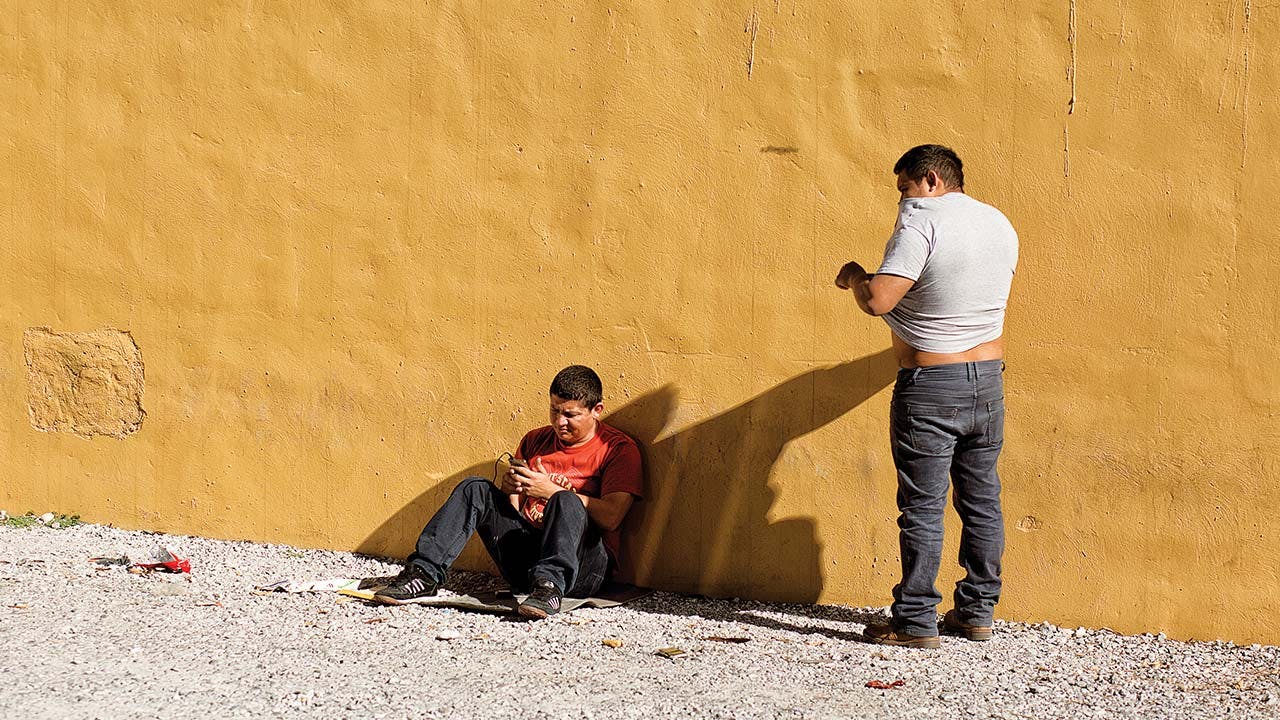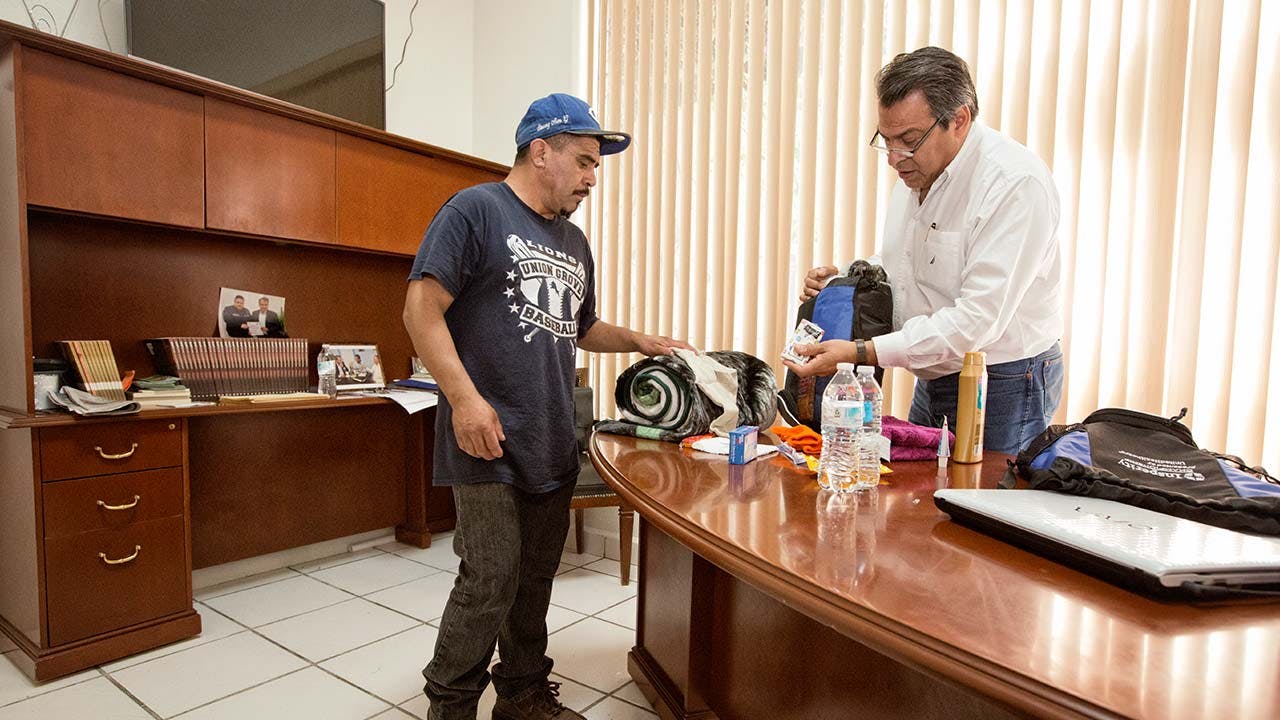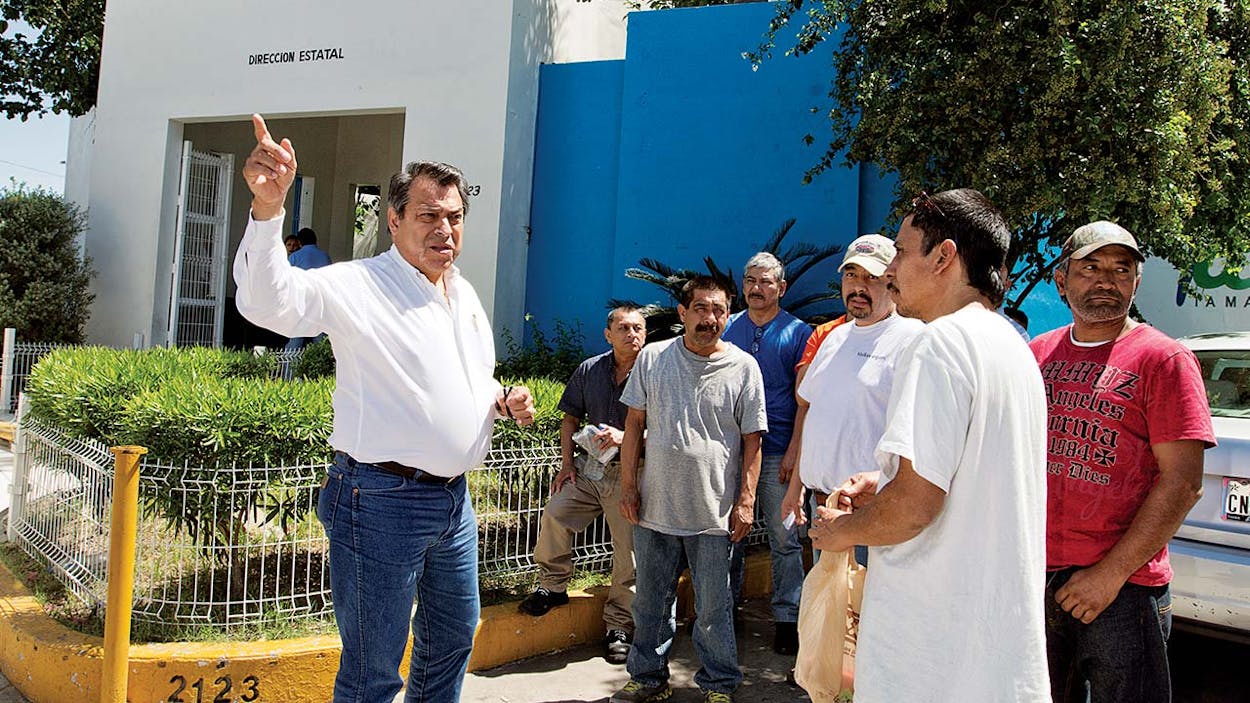On a recent morning in Nuevo Laredo, Marciano Santiago sat in a white plastic folding chair waiting his turn to use the phone at the Instituto Tamaulipeco para los Migrantes, a state agency that provides humanitarian assistance to migrants. Near him, in identical chairs, sat four new arrivals: a bricklayer, a factory worker, a McDonald’s fry cook, and a gardener, each holding the sum of his meager possessions in clear plastic bags. Earlier that day, U.S. immigration officials who had held the four men in custody in Laredo took them across the Gateway to the Americas International Bridge and left them in the hands of Mexican officials. Eventually, they ended up here.
Santiago, on the other hand, had already been in town for a while, following his second failed attempt to cross over into Texas. His first attempt had come to an abrupt end weeks earlier, when his wife fell from the top of the border fence in deep South Texas and broke her leg. Border agents rushed her to a hospital, and the 44-year-old Santiago was deported to Reynosa. Desperate to reach his wife, who was facing her own deportation proceedings while recovering from her injury, Santiago decided to cross the border again. This time, he’d tried his luck in Nuevo Laredo. But he was caught and deported yet again.
By that point, Santiago’s debt to smugglers topped $12,000, an overwhelming sum to earn back home in Veracruz. Yet he was determined to make it to the States, where he had once lived for more than a decade. He quickly found a smuggling outfit that he thought would get him across. As it turned out, these men had no intention of helping him out; they held him for ransom instead. Santiago spent days imprisoned in a dimly lit stash house, until his brother scraped together $3,000 in ransom and he was released.
Since then, Santiago had holed up in a migrant shelter, leaving its relative safety only to call his wife from the humanitarian office. Despite all that had happened, he felt he had no choice but to try to make his way to the U.S. again. Sitting in that plastic chair, waiting his turn to use the phone, Santiago offered a bleak outlook. “It’s difficult to get across the border,” he said. And then he smiled slightly. “But it’s more difficult to be here.”

After his phone call, as Santiago stepped outside, gazing enviously at the cars bound for Laredo, another group of deportees brushed past him on their way into the humanitarian office. Later, still more would arrive. They were Mexico’s problem now.
President Donald Trump’s immigration policy, which is based on the belief that immigrants take American jobs and pose a security risk, has two central aspects: deporting millions of immigrants and building a “big, beautiful” wall along the border. Most critics of this plan have focused on the harm this will do to families in the U.S., many of whom will be torn apart. Others have noted that the U.S. economy may suffer as a source of cheap labor is depleted. But lost in these discussions is the stark reality of what will happen in Northern Mexico. Right now, the three largest cities in the state of Tamaulipas—Nuevo Laredo, Reynosa, and Matamoros—teem with desperate migrants trying to reach the U.S. If Trump has his way, these cities could soon become the site of a full-blown humanitarian crisis.
Many people you meet in the borderlands of Tamaulipas are from somewhere else or on their way to some other place. With its elongated panhandle, 230 miles of border with Texas, and several large cities that hug the international line, Tamaulipas has turned into a sort of funnel for the inexorable ebb and flow of migration. Migrants headed north are smuggled through the state; others are deported back across the border.
It would be difficult to overstate the perils facing these people. They move in the shadows, seeking out smugglers to get them across the border, all the while prey to local criminal gangs, or the drug cartels, who kidnap them for ransom, draft them as rank-and-file soldiers, or put them to work in the sex trade.
For years, many Mexicans were unaware of—or feigned ignorance of—this dire situation. The gruesome discovery in 2010 of a mass grave containing the decomposing bodies of 72 Central and South Americans on a ranch in Tamaulipas changed that. The immigrants had been slaughtered for refusing to join the ranks of the savage Zetas cartel, and the San Fernando Massacre shocked a nation in the midst of a full-scale drug war.

The following year the Mexican federal government enacted a law designed to protect the human rights of migrants. But the law hasn’t amounted to much. Federal funds for deportee assistance are distributed based on the amount of money that people in each state receive from family and friends living abroad. Though Tamaulipas takes in a third of all deportees and huge numbers of migrants, its share of such remittances is small. Last year, when $15 million was budgeted for the entire country, Tamaulipas was slated to receive just over $500,000—but saw none of it, according to José Martín Carmona Flores, the director of the Instituto Tamaulipeco.
The state does have a bare-bones response infrastructure in place, and coordination with U.S. immigration officials allows it to anticipate deportations. The government has created programs to help the newly arrived, like one that offers discounted bus tickets for deportees who are returning to their hometowns. Carmona’s agency, which operates on a meager budget, picks them up from the bridge to minimize their exposure to gangs, but he can’t do much more than that. The task of caring for migrants falls largely to a handful of shelters and churches, which have few resources.
To get a sense of what things might look like in Tamaulipas if deportees begin pouring in, one need look no further than the plight of the Cubans in Nuevo Laredo. For decades, under the Cuban Adjustment Act, a 1966 law that allowed refugees from the Castro regime to stay in the U.S. if they found their way here, Cubans have crossed the border in substantial numbers. Barack Obama abruptly ended their privileged status in January, which had the unhappy result of stranding hundreds still en route in Tamaulipas. As many as 1,100 Cubans are stuck in Nuevo Laredo, taking up residence at migrant shelters, churches, and hotels, straining precious resources. (The entire state has only 660 beds designated for migrants.)
With nowhere to go, the Cubans have proved to be tempting targets. In February, three men armed with assault rifles stormed a seedy downtown hotel where a group of Cubans had been staying. A few of the Cubans escaped through a second-floor window, alerting a military patrol, who foiled the attempted kidnapping.
“I’m afraid,” said Jande Iglesia, a 32-year-old metalsmith from Cuba, who was one of the intended victims of the attack. “Nuevo Laredo is very violent. There is no security.”

Last year Tamaulipas took in about 57,000 deportees, spread across Nuevo Laredo, Reynosa, and Matamoros—about 150 arrivals a day. If the Trump administration pursues the 2 to 3 million deportations it has promised, the Tamaulipas border could see the number of deportees it welcomes quadruple this year alone.
And those are just the Mexicans. The Trump administration is threatening to deport back to Mexico not only Mexican nationals but other foreigners who came to the U.S. across the Mexican border—mostly Central Americans fleeing the violence of the Northern Triangle. Such people are even more vulnerable than the Mexican deportees who crowd the border.
“For Mexicans, the situation is easier,” said Guadalupe Correa-Cabrera, an immigration expert at the University of Texas Rio Grande Valley. “You’re talking about people in their country who can utilize families and networks. If they don’t make it, they can just go home.” For the many Guatemalans, Hondurans, and Salvadorans who show up in Tamaulipas, that’s a more difficult task.
If you ask the people who deal directly with migrants, they will tell you, without much prompting, the number of deportees they consider to be the breaking point for their organizations. “If they send four hundred or five hundred people a day, okay, I can handle that,” Carmona said. “If they send me one thousand it will be chaos.” That’s when the snarl of people will spill out onto the streets, leading to increased kidnappings and disappearances.
Father Giovanni Visoto, the director of the Casa del Migrante Nazareth, in Nuevo Laredo, said his number is 150 deportees. Though the Catholic-run shelter can comfortably house 140 people, daily occupancy recently has hovered closer to 160, requiring some creativity to accommodate them all. Lately milk and bread have been hard to come by, forcing Visoto to turn away all but the most desperate arrivals. Should a large surge of deportees show up at his doorstep, that sort of triage will become even more fraught. “Until now we’ve managed, thanks to donations,” he said. “Who knows how long it will last?”
Pastor Aaron Méndez, who runs Casa del Migrante Amar, has already surpassed his number, with two hundred people, most of them Cubans, crowding into a space designed for half that many. Migrants lie on mats in dark, dank rooms. Some sleep in the open, where the best spots are as far as possible from overflowing bags of garbage and a row of showers. It’s not pleasant, but that’s not Méndez’s primary concern. “What worries me are the delinquents who are intimidating migrants, kidnapping them, trying to make money off them,” he said.
The only small ray of hope is that, as the number of deportees explodes, the number of people traveling north to cross the border will drop. In fact, a sort of “Trump effect” has already taken hold. Last December, U.S. land ports along the southwest border were inundated with asylum seekers; today, the flow has dwindled to a trickle. But Carmona believes that a large jump in the number of deportees would more than offset a decline in the number of northbound migrants. “In this environment of uncertainty we have to prepare for the worst,” he said. “Psychologically, it’s exhausting for us.”
Aaron Nelsen is the Rio Grande Valley correspondent for the San Antonio Express-News.
- More About:
- Politics & Policy







